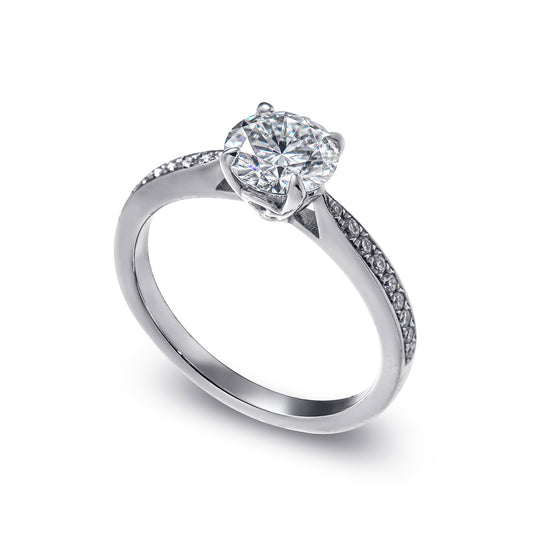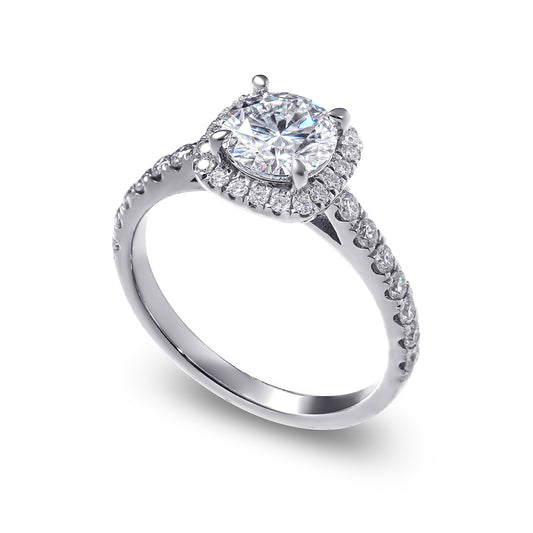-
LAB-GROWN DIAMONDS
What Are Lab-Grown Diamonds?
-

While natural diamonds are formed deep underground, lab-grown diamonds (also known as synthetic or man-made diamonds) are created above ground in laboratories. Apart from the environment in which they are produced, they share the same composition and properties as natural diamonds and are different from simulants such as moissanite or cubic zirconia.

-
- 1 -
ELEMENT
Composition of Lab-Grown Diamonds
Lab-grown diamonds have the same composition as natural diamonds—they are genuine diamonds. Their beauty is on par with natural diamonds, and even professional graders cannot tell them apart with the naked eye. Only with advanced instrumentation can subtle differences in growth patterns or inclusions be distinguished.


Individuality in Lab-Grown Diamonds
Being grown in a lab does not mean mass-produced uniform quality. As with natural diamonds, size and color vary from stone to stone, and not all are high grade. By cutting and polishing each rough stone to bring out its brilliance—just as with natural diamonds—each gem shines uniquely. We select stones with CUT of GOOD or higher, CLARITY of VS2 or higher, and COLOR of F or higher. Other grades can be prepared upon request. For our 4C standards, please see Quality Standards. -
- 2 -
HOW TO
How Lab-Grown Diamonds Are Made
There are two primary methods for growing diamonds in a lab.
-

-
CVD
In the newer Chemical Vapor Deposition (CVD) method, carbon-bearing gas is deposited onto a thin diamond seed, growing diamond crystal layer by layer. “CVD” stands for Chemical Vapor Deposition.
-
HPHT
A long-studied method that replicates the high-pressure, high-temperature conditions under which natural diamonds form underground, producing diamond crystals from carbon sources. “HPHT” stands for high-pressure, high-temperature. -

-

-
HPHT
A long-studied method that replicates the high-pressure, high-temperature conditions under which natural diamonds form underground, producing diamond crystals from carbon sources. “HPHT” stands for high-pressure, high-temperature.
Both methods are widely used today. For large, high-clarity colorless diamonds and fancy-colored stones, CVD is often more suitable.
-
-
- 3 -
PRICE
Price of Lab-Grown Diamonds


Lab-grown diamonds are typically one-half to one-third the price of natural diamonds. You might allocate the savings to your wedding, travel, or beauty—or choose a larger lab-grown stone within the same budget. For details, see our Transparent Pricing page.
-
- 4 -
ENVIRONMENT
Lab-Grown Diamonds and the Environment
Lab-Grown Diamonds = A Smart Choice

With identical composition and certification-backed quality, lab-grown diamonds are, we believe, a smart choice for today.

Some choose a larger diamond than first planned; others put the savings toward a honeymoon or home. You can opt for lab-grown with environmental and labor considerations—or choose natural if that’s your preference. Lab-grown diamonds simply expand your options. Please also see our Customer Reviews.
Learn About Lab-Grown Diamonds
- Four Key Points -
FAQ / Frequently Asked Questions
What are lab-grown diamonds?
Lab-grown diamonds are genuine diamonds that are grown in laboratories, not in the earth. They have the same chemical and physical properties as natural diamonds, and are classified as "diamonds" by professional institutions.
They are sometimes called "synthetic diamonds," "artificial diamonds," or "lab diamonds," but they all mean the same thing and are essentially the same substance as natural diamonds. I would be happy if you could think of this as the development of genuine diamonds through scientific advances.
What is the difference between natural and lab-grown diamonds?
The main difference is where they are produced. Natural diamonds are produced deep underground, while lab-grown diamonds are produced on the ground (in a lab). They have the exact same components and characteristics as natural diamonds, except for the environment in which they are produced.
How are lab-grown diamonds different from moissanite and cubic zirconia?
Lab-grown diamonds are "diamonds themselves," with the exact same chemical composition (100% carbon) and crystal structure as real diamonds. On the other hand, moissanite and cubic zirconia (CZ) are imitation stones or simulants made to resemble diamonds, and are completely different minerals.
<Lab-grown diamonds>
Chemical composition: Carbon (C) / Mohs hardness: 10 / Brilliance: Diamond equivalent
<Moissanite>
Chemical composition: Silicon carbide (SiC) / Mohs hardness: 9.25 / Luster: Iridescent
<Cubic zirconia>
Chemical composition: Zirconium oxide (ZrOs) / Mohs hardness: 8-8.5 / Shine: Strong, weaker in dim light
Are lab-grown diamonds fake?
They are not fake. Unlike cubic zirconia or moissanite, they are "real diamonds" whose structure, hardness, and brilliance all match those of natural diamonds. Many gemological institutions (e.g., IGI and GIA) will issue official certificates.
Can you tell the difference between them and natural diamonds by appearance?
They are indistinguishable to the naked eye, but can be distinguished under a microscope by looking at special inclusions and growth patterns, which requires specialized laboratory analysis.
Why is the price so low?
Lab-grown diamonds do not require mining or distribution costs and pose little environmental or humanitarian risk. In addition, by operating an online store, we are able to cut labor costs and fixed store costs, allowing us to maintain high quality while offering affordable prices.
Is it okay to choose it as a wedding ring or engagement ring?
Of course, that's OK. People choose us for a variety of reasons. We receive support from couples who value ethical choices, people who want to spend money on their honeymoon or wedding, people who want to get the ideal grade or size of their diamond within a budget, and many others who prefer the same diamond at an affordable price.
Please consider this for your wedding ring or engagement ring.
Is there a certificate of authenticity?
Diamonds over 1 carat come with a certificate. We can also provide a certificate as an option for diamonds under 1 carat to 0.3 carats upon request.
Our lab-grown diamonds come with a certificate issued by a highly reliable grading institution (IGI or GIA), which also includes the 4Cs of carat weight, color, clarity, and cut.
Are there any precautions to take in terms of maintenance or handling?
Like natural products, lab-grown products are hard and scratch-resistant, but please avoid strong impacts and oily or cosmetic stains. We recommend regular cleaning and inspection.
Who chooses lab-grown diamonds?
<Design>
・Those who want to realize their ideal design within a set budget
- People who want to customize the shape of large diamonds that are difficult to obtain with natural diamonds.
・Those who want to choose a colored diamond of their choice
<Environmental and ethical aspects>
・Those who want to consider sustainability and the environment
・People who have doubts about conflict diamonds
- People who are convinced of the progress of new technologies
<Cost>
・People who want to purchase high-quality diamonds at a low cost
・People who want to spend money on their honeymoon and wedding ceremony rather than on the ring
・People who prefer the same diamond at a more affordable price
<Presents>
- People who want to give gifts to their family members for wedding anniversaries, Mother's Day, 60th birthdays, etc.







